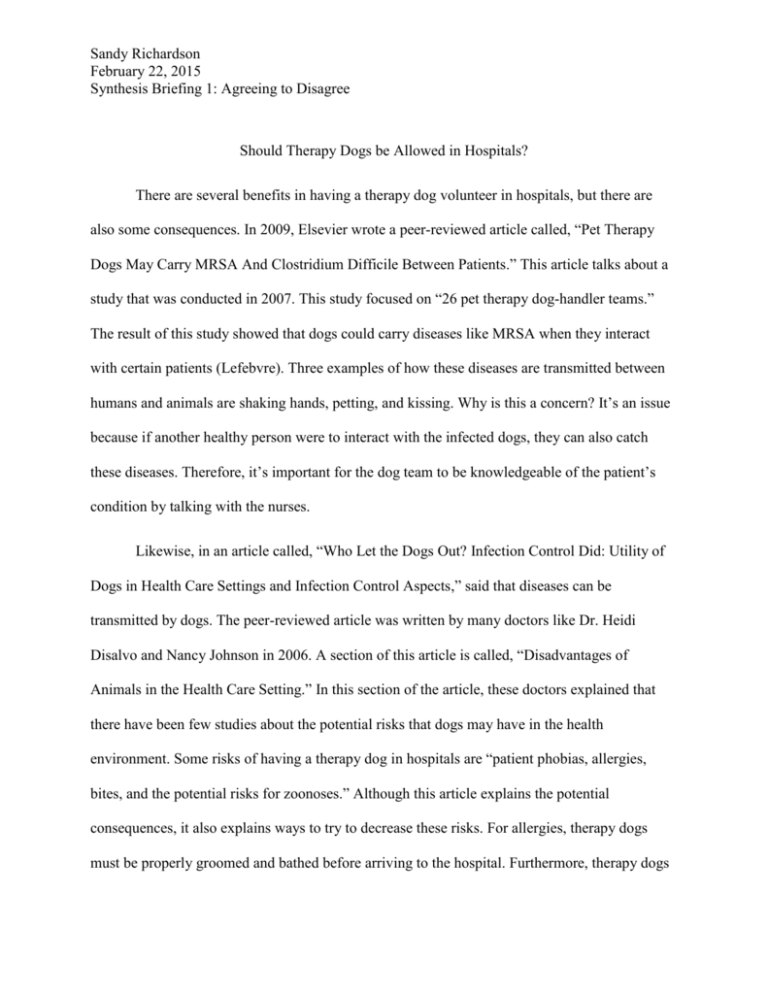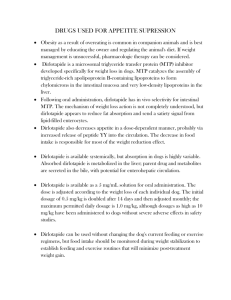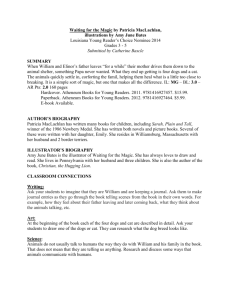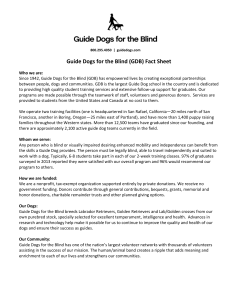Synthesis Briefing 1
advertisement

Sandy Richardson February 22, 2015 Synthesis Briefing 1: Agreeing to Disagree Should Therapy Dogs be Allowed in Hospitals? There are several benefits in having a therapy dog volunteer in hospitals, but there are also some consequences. In 2009, Elsevier wrote a peer-reviewed article called, “Pet Therapy Dogs May Carry MRSA And Clostridium Difficile Between Patients.” This article talks about a study that was conducted in 2007. This study focused on “26 pet therapy dog-handler teams.” The result of this study showed that dogs could carry diseases like MRSA when they interact with certain patients (Lefebvre). Three examples of how these diseases are transmitted between humans and animals are shaking hands, petting, and kissing. Why is this a concern? It’s an issue because if another healthy person were to interact with the infected dogs, they can also catch these diseases. Therefore, it’s important for the dog team to be knowledgeable of the patient’s condition by talking with the nurses. Likewise, in an article called, “Who Let the Dogs Out? Infection Control Did: Utility of Dogs in Health Care Settings and Infection Control Aspects,” said that diseases can be transmitted by dogs. The peer-reviewed article was written by many doctors like Dr. Heidi Disalvo and Nancy Johnson in 2006. A section of this article is called, “Disadvantages of Animals in the Health Care Setting.” In this section of the article, these doctors explained that there have been few studies about the potential risks that dogs may have in the health environment. Some risks of having a therapy dog in hospitals are “patient phobias, allergies, bites, and the potential risks for zoonoses.” Although this article explains the potential consequences, it also explains ways to try to decrease these risks. For allergies, therapy dogs must be properly groomed and bathed before arriving to the hospital. Furthermore, therapy dogs Sandy Richardson February 22, 2015 Synthesis Briefing 1: Agreeing to Disagree are only allowed to see patients if they have permission. These cautions should minimize allergic reactions. Another concern is biting because of the possibility of rabies. This article says that immune globulin is available in case a patient is bitten. The last concern is the transmission of infectious diseases. The authors wrote that “animals should not be allowed to visit with patients who are infected or colonized” with zoonotic diseases (DiSalvo). Thus, according to these two peer-reviewed articles, there are risks and benefits in having a dog in a hospital. Although there are risks such as allergies and diseases. These are preventable or can be minimized in the hospitals. Therefore, there should be therapy dogs in hospitals because they improve the environment for staff and patients, but there should also be restrictions on where the therapy dogs are allowed to go. Citations DiSalvo, Heidi, Haiduven, Donna, Johnson, Nancy, Reyes, Valentine V., Hench, Carmen P., Shaw, Rosemary, and Stevens, David A. "Who Let the Dogs Out? Infection Control Did: Utility of Dogs in Health Care Settings and Infection Control Aspects." AJIC: American Journal of Infection Control 34.5 (2006): 301-07. Print. Lefebvre, S.L., and Weese, J.S. "Contamination of Pet Therapy Dogs with MRSA and Clostridium Difficile." Journal of Hospital Infection 72.3 (2009): 268-69. Web.





